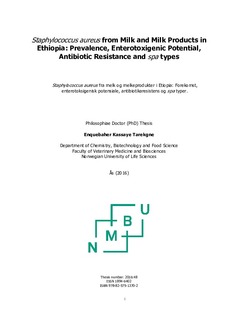| dc.contributor.advisor | Narvhus, Judith | |
| dc.contributor.advisor | Skjerdal, Taran | |
| dc.contributor.advisor | Skeie, Siv | |
| dc.contributor.advisor | Rude, Knut | |
| dc.contributor.author | Tarekgne, Enquebaher Kassaye | |
| dc.coverage.spatial | Ethiopia | nb_NO |
| dc.date.accessioned | 2017-12-12T14:16:27Z | |
| dc.date.available | 2017-12-12T14:16:27Z | |
| dc.date.issued | 2017-12-12 | |
| dc.identifier.isbn | 978-82-575-1370-2 | |
| dc.identifier.issn | 1894-6402 | |
| dc.identifier.uri | http://hdl.handle.net/11250/2470865 | |
| dc.description.abstract | Milk production in Ethiopia is increasing. However, due to unhygienic and traditional milk production and processing practices the issue of milk safety remains a challenge. If these safety issues are not properly addressed, the high nutritional composition and neutral pH of milk may convey many milk-borne pathogens, including Staphylococcus aureus, which imposes health risks to the consumer. S. aureus is an important food-borne pathogen globally as it can cause staphylococcal food poisoning (SFP) and also readily develops antibiotic resistance.
The objectives of this study were: i) to study the distribution of S. aureus and other Staphylococcus species in milk and milk products along the milk value chain of the studied area; ii) to assess the enterotoxigenic potential of the S. aureus isolates; iii) to evaluate the antimicrobial resistance profiles of the S. aureus isolates to 12 antibiotics commonly used in the studied area and verify the presence or absence of methicillin-resistant S. aureus (MRSA) iv) to assess the genetic relatedness of the enterotoxigenic and multidrug resistance (MDR) S. aureus strains using spa tying method; v) evaluate the performance of real time PCR (qPCR) targeting the nuc gene for quantification of S. aureus in bulk milk, in comparison with the plate count method. | nb_NO |
| dc.description.abstract | Melkeproduksjon øker i Etiopia. Imidlertid er mikrobiologisk trygghet av melk en utfordring på grunn av uhygienisk og tradisjonell melkeproduksjon og prosessering. Om disse sikkerhetsaspektene ikke blir tilstrekkelig adresserte, kan melkens høye næringsinnhold og nøytrale pH føre til at melk blir bærer av mange matbårne patogener, inkludert Staphylococcus aureus. Dette representerer en helserisiko for konsumenten. S. aureus er en viktig matbåren patogen fordi den kan forårsake stafylokokkintoksikasjon, og lett kan utvikle antibiotikaresistens.
Målene for dette studiet var: i) å studere distribusjon av S. aureus og andre Staphylococcus arter i melk og melkeprodukter langs verdikjeden i Tigray regionen; ii) å vurdere potensialet for enterotoksinproduksjon hos S. aureus isolatene; iii) å evaluere resistens hos S. aureus isolatene mot 12 ulike antibiotika som brukes ofte i Tigray regionen, samt verifisere tilstedeværelse av meticillin-resistente (MRSA); iv) å vurdere genetisk slektskap, ved hjelp av spa-typing, hos de enterotoksigene og antibiotikaresistente (MDR) isolatene; v) evaluere kvantifisering av S. aureus i melk ved hjelp av real time PCR (qPCR ) basert på nuc genet, sammenlignet med platetelling. | nb_NO |
| dc.language.iso | eng | nb_NO |
| dc.publisher | Norwegian University of Life Sciences, Ås | |
| dc.relation.ispartofseries | PhD Thesis;2016:48 | |
| dc.rights | Navngivelse-Ikkekommersiell-IngenBearbeidelse 3.0 Norge | * |
| dc.rights.uri | http://creativecommons.org/licenses/by-nc-nd/3.0/no/ | * |
| dc.title | Staphylococcus aureus from milk and milk products in Ethiopia : prevalence, enterotoxigenic potential, antibiotic resistance and spa types | nb_NO |
| dc.title.alternative | Staphylococcus aureus fra melk og melkeprodukter i Etiopia : forekomst, enterotoksigenisk potensiale, antibiotikaresistens og spa typer | nb_NO |
| dc.type | Doctoral thesis | nb_NO |
| dc.source.pagenumber | 1 b. (flere pag.) | nb_NO |

